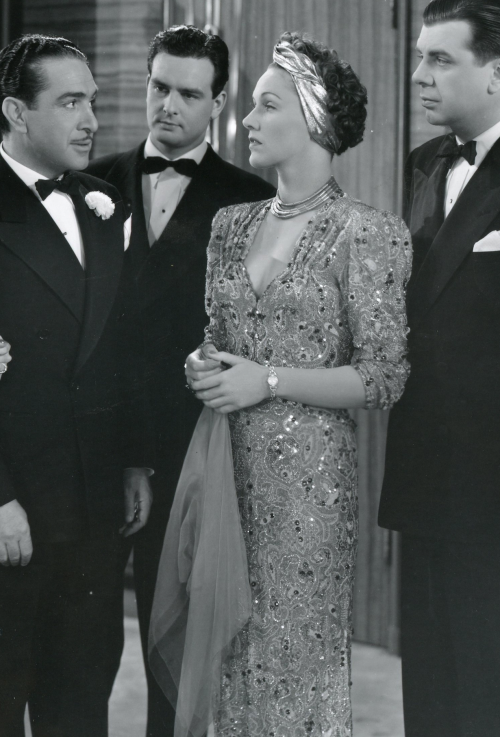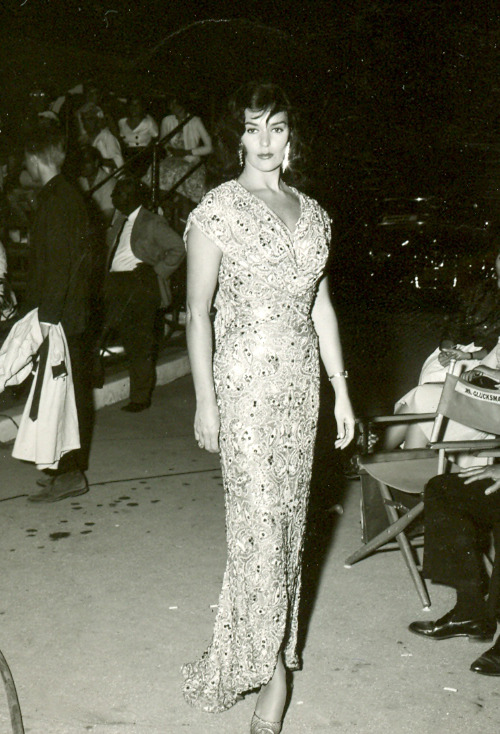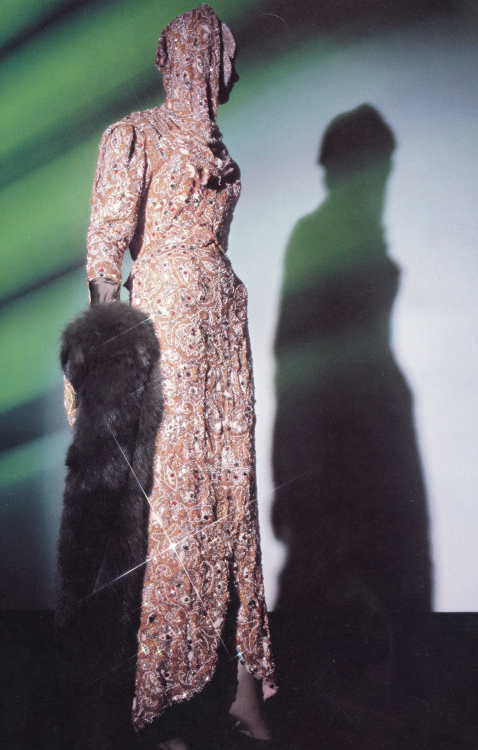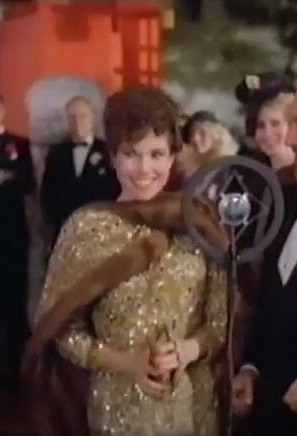Goodness do I have a treat for all of you today. Larry McQueen, owner of The Collection has sent me
Goodness do I have a treat for all of you today. Larry McQueen, owner of The Collection has sent me a lovely sighting filled with detailed information. Because the detail is frankly incredible, I decided not to edit it and present Larry’s notes in full below:In 1936, Travis Banton, head designer atParamount Studios, began work on the last film he would design for his favoriteclotheshorse, Marlene Dietrich. The duo had worked closely together on all herfilms at Paramount and created the “Dietrich style”– a look of lavish,smoldering, hard-edged sophistication that was instrumental in creating theDietrich legend. Dietrichhad one final film to complete her contract at Paramount and was cast in atypical Dietrich vehicle Angel, a sophisticated Lubitsch melodrama with herin the role of an ignored wife of means who has an affair with her husband’sfriend. Banton designed the most opulent dress he had ever created for the starfor the under-five-minute opera sequence and preceding scenes in the film. The ensemblewas to become known as the “Faberge” gown and consisted of a fitted long-sleevebodice with peplum, a matching long skirt with train and a six foot stolebordered with sable. The fabric was solidly embroidered with gold beads,pearls, rhinestones, gold bullion, gold sequins and faux ruby and emeraldstones in geometric designs. According to W. Robert Levine in his book “In AGlamorous Fashion,” the costume was cost-listed on the wardrobe records at$8,000.00, an exorbitant price in the post-depression era and a price thatwould be over $100,000.00 by today’s standards. The expense must have causedstirrings in Paramount’s upper management in a time when the government wasasking the studios to scale back the unnecessary lavishness in costume design.Banton himself once said it was the most expensive gown he had ever designed. Theensemble is given credit in many film costume books as the most spectaculargown ever created. Diana Vreeland, one-time curator at the Metropolitan Museumof Art said of the costume in the book “Hollywood Costume– Glamour! Glitter!Romance!” “When I think of detail, I think of Travis Banton’s marvelous beadeddress for Marlene Dietrich in Angel—like a million grains of golden caviar.That is one of the most beautiful dresses ever…”. Margaret J. Bailey in herbook Those Glorious Glamour Years describes the dress “It was simple inlines, of Persian design, and looked like a piece of woven jewelry…” and “… caused no little trauma on the setwhen producers refused to give it to Dietrich for her private wardrobe.” Dietrichhad loved the gown and asked the studio if she could keep it. It is said shewas so angry of being refused by the company she help save, she stormed off theset. The incident no doubt added to her disharmonious departure from thestudio. She left the studio and did not return until a decade later. Acquiringgowns and props from her films- by whatever means- was a general practice ofMs. Dietrich. After her death, The German Film Archive Foundation (die StiftungDeutsche Kinemathek) and The Berlin Film Museum acquired her estate in 1993,which consisted of five different storehouses in Europe and the USA. In thecollection were thousands of items from her career including fifty of her mostfamous film gowns. Her daughter, Maria Riva, once told the curator of theFrankfurt Film Museum, her mother was always in constant fear the studios wouldsomeday try to take back her collection and had kept the fact of its existencewell hidden.Paramount,however, retained the piece and began to put it to use. Re-using costumes was acommon practice by studios to maintain an opulent look to secondary andbackground characters without the expense of making new ones. It is unknownexactly how many films the Dietrich gown was used in, but from photos found, itis obvious it was put to work and went through many transformations in theprocess. Mary Astor wore it, without the stole on the set of Midnight, 1939.The front was reworked and worn by Rose Hobart in the film A Night at EarlCarrolls, 1940. It was used in publicity photos as in that of Loraine Daycirca 1944. With the sleeves removed, the stole without the fur was added tothe front of the bodice as draping, it was worn by Felicia Atkins in TheErrand Boy, 1961. The stole was cut in half to be used as a turban and wornwith a sleeveless altered bodice by a model in A New Kind of Love, 1963. In1974, the bodice was put back together and used by Diana Vreeland in the METexhibition of films fashion and in 1985, the gown and stole was returned to itsoriginal configuration and worn by Barbara Hershey in the TV movie My WickedWicked Ways.Withall the different uses, the pieces took a beating. Many of the “re-workings”were fast and crude and some of the attempts to repair the gown involvedcovering damaged areas with large gold sequins. One previous ‘restoration’involved applying glue to areas and pushing the beads back together and lettingit harden. The fine chiffon backing was weak and starting to split and thepatterns were separating. The costumewas so fragile, it could never be worn again, but it is amazing the piecesstayed together.InDecember of 1990, Paramount put the gown up for auction at Christies New Yorkas part a larger collection of ‘star wardrobe.’ Larry McQueen and his late business partner, Bill Thomas, who wererespected experts in the field of film costumes and had compiled one of thefinest collections of the medium under the name “The Collection,” were retainedto help inventory, authenticate and price the collection and were overwhelmedto see, what they believed to be, the most exquisite film costume ever created.They were successful in purchasing it for a total cost of approximately$23,000.00, one of the highest prices at the auction. As excited as they wereto own the gown, the reality of its condition soon set in. Due to the age ofthe garment, poor storage and multiple alterations, it could never be dressedon a mannequin because it would not support its own extreme weight. In1999, four years after Bill Thomas died, Larry McQueen began the process ofrestoring the costume. Museum experts in preservation and restoration wereconsulted and much debate occurred as to whether the integrity of the gown-however poor that integrity was- should be tampered with. It was finallydecided by Mr. McQueen that instead of leaving it as it was- a box ofun-showable beads- the ensemble should be restored. Getson/Eastern Embroidery,who was then owned by Annie Dernderian, was approached with working on thegown. The firm had worked on the original costume and luckily had many of thebeads, sequins and stones used on the original construction.But, restoration ofthe garment proved far more difficult than planned. Even though the gown hadonly taken weeks to create, it would take years to restore. Every inch of thebeadwork would have to be attached to new chiffon backing and the patternspulled into shape and lightly tacked. Then the patterns had to be permanentlyhand stitched, replacing any missing stones or beads. Previous poor repairswould have to be removed. Missing areas or areas that had been glued would haveto be replaced. Many of the original silk threads that attached the beads werebreaking and would have to be reinforced with new silk thread. The stole, whichhad been cut in half and then stacked on top of its self and re-sewn, had to betaken apart, attached to a new backing and the beading attached andcorrected. Photographs of Dietrich wearingthe costume were enlarged to determine what was an original pattern and whathad been changed. Luckily, the patterns did repeat themselves, so where apattern was missing, a template of an existing pattern was made to re-createthe missing one. The task would involve going inch by inch and would involvethousands of hours and great expense. But, determined to see the gown restored,Larry McQueen had the work begun.The gown could not betaken apart and beaded flat as it was originally constructed, so a specialframe with a sling had to be constructed to allow access to the inside of thegarment to work from the front and the back of the fabric. Beads and sequinsthat had to be removed were sorted and reattached in to same location ifpossible. Only a four-inch area could be worked on at one time and each areawas photographed before and after to document the work done. The project wasdaunting. Theentire fabric of the costume is composed of repeating geometric shapes somewhatlike a paisley pattern. Each shape is outlined with small pearls or facetedrhinestones. Beads, pearls or sequins in different combinations fill the centerportions of the design. Throughout, are patterns that contain a small grid workof bullion threading and each square filled with small pearls, sequins or acombination of sequins and gold beads. The background is of solid gold rocaillebeads and the gown is sporadically studded with emerald and red glass beads.Literally millions of beads were used to create the fabric of the ensemble. Afterone year, only the bodice was approaching completion, most of the work done byAnnie Denderian. But the expense was mounting and it was becoming impossible tofind qualified people who had the patience and time to spend on the garment.Mr. McQueen decided that if the costume was to be completed, he would have totake over the bulk of the hands-on restoration. Having the background and moreimportantly the motivation to see the gown completed, he was mentored by Ms.Denderian, learning and perfecting the techniques to painstakingly re-attachthe patterns and began work on the dress. Almost one year to the date ofbeginning the work- working faithfully five to eight hours a day- the skirt andthe stole were completed. To add strength, bias tape reinforcing and a new silkchiffon lining was added by the costume house of John David Ridge and the stolewas re-bordered by using existing sable by Judith Moss at LA Fur Center.McQueen stated thathe probably would have reconsidered restoring the gown had he know the time,patience and expense it was going to take, but then quickly adds that he wouldhave done it anyway. It was just too important. In working that closely withthe piece, McQueen was amazed how in touch you get with the people whooriginally created the garment (a process difficult to understand unless youhave restored someone else’s creation). You could tell when someone was havinga bad day and cutting corners. You could tell when someone was struck withgenius. You could see the differences in workmanship and technique between thevarious beaders. You could see the time spent on details in areas that no onewould ever see. You become very close to the garment and understand it.Thegown is truly a testament to the artistry of early Hollywood. Mr. McQueen isconfident the care, attention and over 3000 hours spent in its restorationwould make its original creators proud. He hopes that if he leaves any legacyto the field of film costumes, one of his main accomplishments will be the“Faberge gown” survives in the splendor it was originally created and will beshown and appreciated for generations to come.Costume Credit: Photos, copy and all the above incredible info provided by The Collection of Motion Picture Costume Design: Larry McQueenE-mail Submissions: submissions@recycledmoviecostumes.comFollow: Website | Twitter | Facebook | PinterestNote: If you’ve not checked out Larry McQueen’s The Collection, I highly suggest you do so. It’s incredible! -- source link
Tumblr Blog : recycledmoviecostumes.tumblr.com
#marlene dietrich#travis banton#mary astor#larry mcqueen#the collection#costume drama#costumes#period drama#fallen angel#midnight






